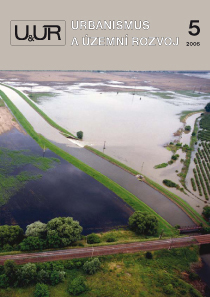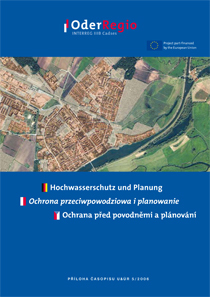

Flood Prevention in the New Building Act, by Martin Tunka & Marie Polešáková
Some Czech regions suffered from floods last spring again, so words like flood, deluge, overflow, emergency, natural disaster, and so on, were frequently used. In this respect, it was often remarked that the new Building Act would help and solve the problems of the renewal of affected zones. To enter in vigour on 1 January 2007, this needful Act was passed and published by the Czech Parliament as the 283/3006 Act, replacing the current legislation, valid ever since 1976 with some two dozens of amendments.
The new Building Act does not include specific instructions for the solution to problems of floods, deluges, overflows, emergencies, or natural disasters. In spite of that, a number of regulations related to flood prevention can be found. For a better orientation, such paragraphs were extracted from the Act to be published in this contribution.
What Does the Plan of Major River Basins Say about Flood Protection, and Why? by Evžen Polenka
This article has been written in order to briefly inform about some important changes in the approach to flood protection, as proposed by the Plan of Major River Basins of the Czech Republic, and to present the reasons for such changes. Protection against floods and damage caused by water is one of the three main objectives of the Plan of Major River Basins, a new strategic document about the water resources management in the Czech Republic. One important difference from previous documents of its kind is a substantially bigger stress on prevention. The proposed measures are meant to introduce efficient steps of prevention into the existing flood rescue system.
Spatial Arrangement and Flood Prevention in the Basin of the River Elbe: Procedure Proposals for Multinational Partnership, by Peter Heiland & Katharina Feiden
Prevention from floods has been anchored in the European policy of spatial development as its integral part since the 1990s through the declaration of the EU spatial arrangement ministers. This initiative has boosted some specific activities in the basins of some European rivers, such as the INTERREG II C programme of IRMA on the rivers Rhine and Maas, to give the best example. Since 1999, flood prevention has been explicitly anchored as an objective of the European spatial development in the European Spatial Development Concept (Europäisches Raumentwicklungskonzept, EUREK), aimed at the reduction of regional or local drawbacks and the damage to national economies. This principle was carefully observed in the EU support programmes of regional policies.
For the basin of the Elbe, this fact had long been of secondary importance, as there were more important tasks of multinational spatial arrangement to be solved. Then, in 2002, the efficiency of the INTERREG programme in the basin of the Elbe underwent a proof: after the catastrophe, the responsible authorities were promptly seeking ways for the European policy of spatial development to improve flood prevention in the future. The theory was materialized in the form of the ELLA project, carried out under collaboration of 23 international partners. A reliable network has been built, common attitudes were discussed, an atlas of maps of danger and the systems of flood management were elaborated, regional plans of flood prevention were designed, and much more could be done, all under international coordination. The ELLA project within the INTERREG III B programme, financed by the national partners and the EU, represents a real benefit for the European integration and for the multinational prevention from floods. The subsidy of the project terminates at the end of 2006 but the partners are looking for chances to continue.
This contribution describes the project and its results.
Options and the Economic Efficiency of Flood Prevention Measures, by Ladislav Satrapa, Pavel Fošumpaur and Martin Horský
The floods of April this year have again reminded us of the necessity to count with whatever behaviour of the nature and the danger of floods. In the period between the spring flood and the Czech parliamentary election, floods was a rewarding political topic to talk about. As a result of the floods, and in view of some easy support form the public, the call for flood prevention measures became a rather fashionable argument.
Same as the construction of dry conduit regulators (polders) after the floods of 1997 and 2002, often lacking in profound consideration and concept, isolated and inconsistent construction of local flood prevention mechanisms is now urged in villages and towns. Many polders cannot but control very small river basins, and not all the regulators are fully safe and efficient. On top of that, dry conduit regulators cannot maintain water supply, so it is a pity that multi-functional reservoirs were not built instead, especially so under the increasing demand for water resources. The reconstruction of dry regulators into reservoirs is possible but too expensive.
As was the case with polders, the newest wave of the concern for flood prevention includes inefficient measures or those technically feasible but not environment-friendly (such as high dams or other dominant buildings, hardly acceptable in the landscape). And, another important point has to be mentioned: in the middle ages, there were almost three times more small water reservoirs in the Czech territory than today. Such small reservoirs (ponds) in their large numbers can play a vital role in flood prevention, holding back part of the volume of the deluge and being essential under our geographic conditions (on the “roof of Europe”) to detain and slow down the outflow from our territory. Also important, ponds imply a positive environmental and aesthetic effect. It is the renovation of abandoned small reservoirs what the efforts of municipalities and regional authorities should aim at. The results of such activities will always be positive.
Floods in Municipal Master Plans: Practical Experience, by Ladislav Satrapa
The contribution shows how the questions of floods can be integrated into the physical planning documentation. The presented method makes it possible to manage in detail the problems of floods through regulations for functional areas, taking into consideration all the possible scenarios of danger. Using the risk matrix, the method provides very good qualitative assessment of the hazards in the functional areas of municipal master plans, so that there is enough information available about the priorities in the management of potential flood risks. The method proves to be efficient, and there is a growing demand for its application.
The recent floods and heavy rains, both in early spring and in June, have revealed once again the necessity to face flood risks almost anywhere. Despite the disaster and the harm brought by the floods of the last ten years, nature has still been relatively merciful with us, for there has not been any winter flood, a much more dangerous situation to human lives due to hypothermia.
The effect of the recent floods and the probable changes of the climate indicate that the floods must be regarded as one of the most important aspects of the development and the security of settlements.
GIS–Based Analysis of Flood Risks in the Process of Spatial Planning, by Aleš Dráb
The analysis of flood risks is evolving into an integral part of spatial planning. One of the necessary tools for the practical materialization of the methods of risk analysis in floodplains is the geographic information system (GIS). Their task is to administer input data, analyse them, and present results. This article demonstrates the possibilities of GIS in the process of risk analysis of floodplains, especially focusing on spatial planning applications. As a practical example, the method of the risk matrix was used, which can be easily applied in spatial planning. The opening part of the article deals with the input data, i.e. those about the depths and speeds of water flow in the floodplain. Then the procedure of data processing through the method of the risk matrix, using the GIS, is described. In conclusion, the results of the method are interpreted and evaluated.
A Methodology Proposal for Flood Risk and Damage Assessment in Floodplains, by Karel Drbal
Resulting from a 2002 to 2005 research project, this methodology defines the applicable data resources and contains procedures and methods for the assessment of flood risks. Key problems, groups of input data, and expected results are described, allowing large space for the methods of the formulation of risks (qualitative, semi-quantitative, quantitative) in the context of potential users’ requirements for output information. The usage of the results of the risk analysis in floodplains can be of very large scope, constituting the groundwork for the decision-making about the alternatives of spatial development in endangered zones, for flood prevention, for the planning of the rescue work during floods, for the awareness of the public about the existing risks, and so forth.
Questions of Groundwater Flow in Urbanized Areas, by Jaromír Říha
The occurrence and the flow of groundwater in urbanized areas depend on both natural conditions and anthropogenous activities. Natural conditions means here morphologically broken relief with a network of currents, some of them “buried” and usually draining the adjacent aquifer, while anthropogenous interference means especially changes in the geological composition of the territory, such as anthropogenous geologic layers (back-fills), leakage of water piping, drainage of cellars and subterranean parking sites, or collectors in city centres. Subterranean objects, or parts of buildings, have significant impact on the regime of groundwater flow, while, on the other hand, the occurrence and the regime of groundwater flow is a condition for the technical solution of the subterranean parts of buildings and their construction methods. If there is interaction between the aquifer and the surface water flow, the accession of the groundwater level in the protected area is an important factor during flood episodes.
This article discusses all these factors in detail, giving examples of possible elimination of their negative effects. The presented examples are based on the author’s numerous studies in the problems of groundwater flow in the territory of Brno, Prague, and other urbanized areas.